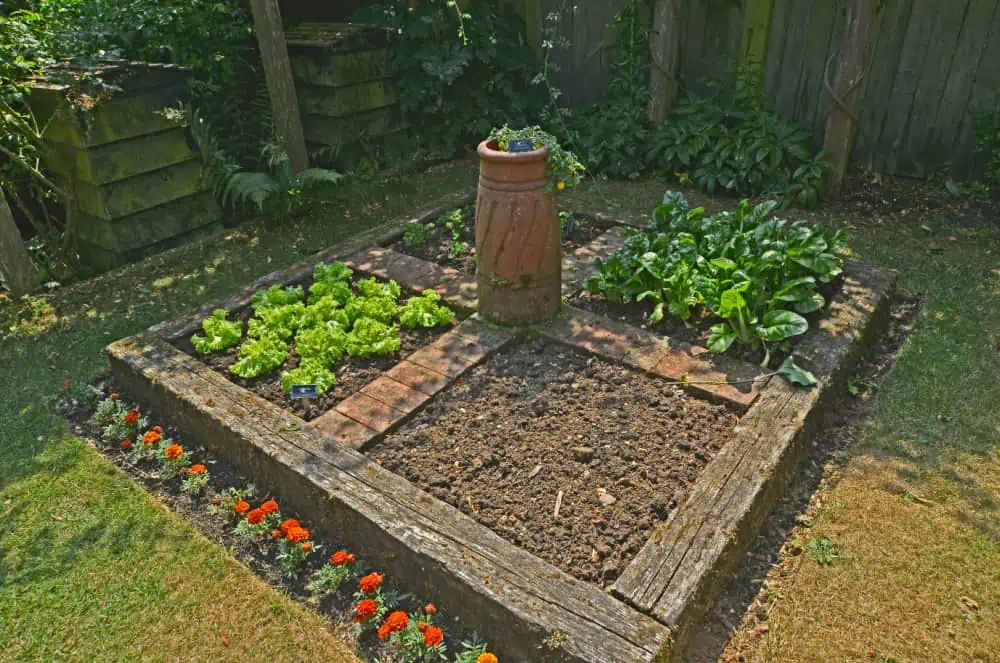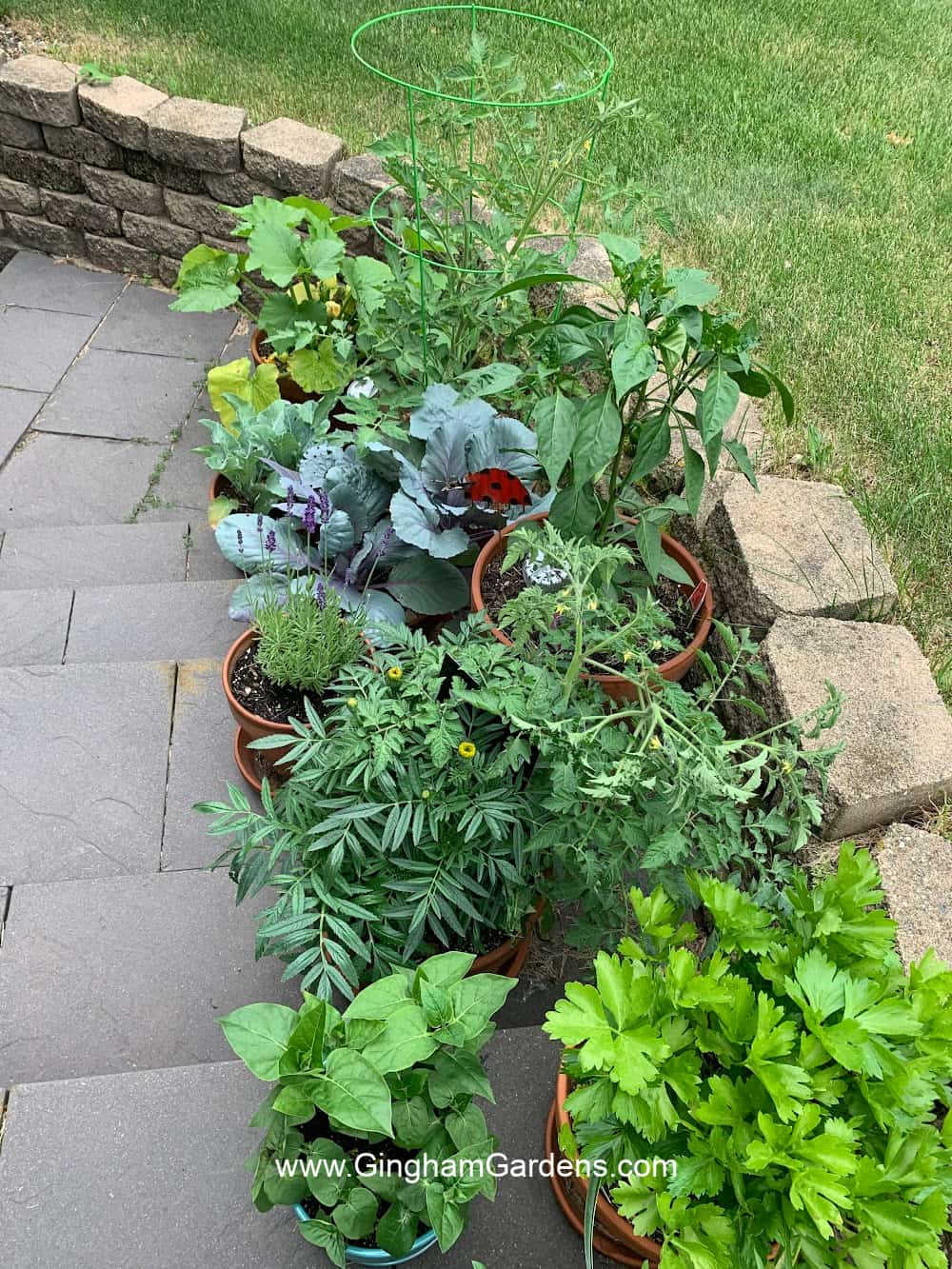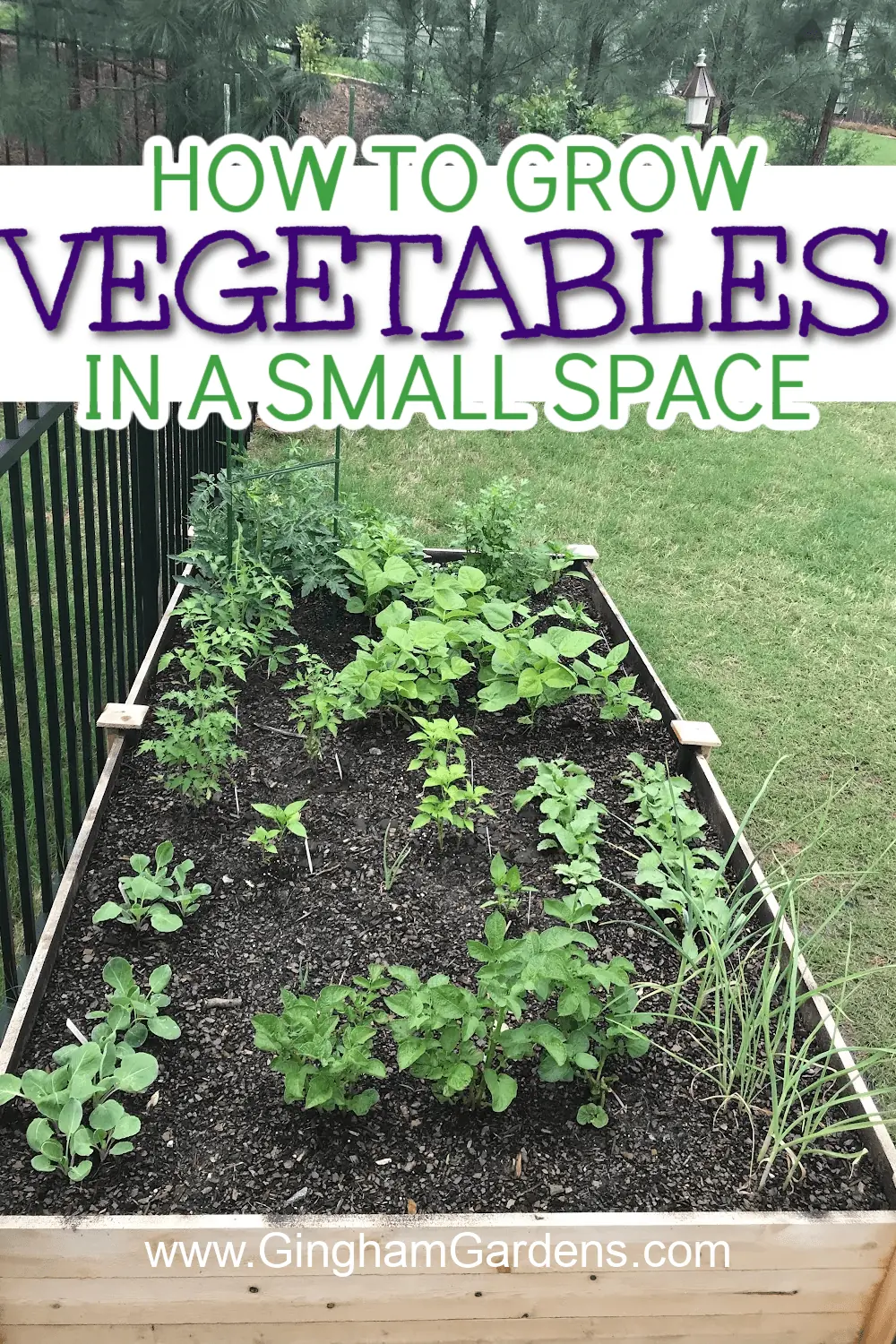Growing Vegetables in Small Spaces
Believe it or not you can grow a variety of vegetables with limited space. Of course, you will need to make a plan, do some research, and simply get started. But I’m here to help you. Today we’re going to talk about why grow vegetables in a small space, how to utilize the space in a small garden, what veggies you can grow in a limited space, and when to get started. Plus, we’ll share lots of tips and ideas so you can have the best results growing vegetables in small spaces.
Not everyone has the option of sprawling garden beds. But we want you to know it is possible to have high yields of your favorite fruits and vegetables even if you don’t have a lot of space.
This post contains affiliate links. If you click on
one of the links and make a purchase,
I may receive a small commission at no additional cost to you.
See full disclosure here.
No time to thoroughly read this post now, save a reminder to your gardening board on Pinterest.
Growing Vegetables Vertically
First, the nature of growing vegetables in a small area means you need to take advantage of the vertical space. The clearance above the ground is prime real estate when you don’t have the ground space. Therefore, reason number 1 to grow vertically is…it saves on space and it’s the best idea for a small vegetable garden.
Second, when you get fruiting plants up off the ground, they are more productive. They naturally get more airflow and sunlight, which is a good way to produce healthier plants and get much more produce. For example, when your vegetables are up off the ground, you have a better point of view. You can see what’s happening with your plants. Finding produce is easier without having to bend over and hunt around prickly vines only to discover an enormous squash or cucumber that you somehow missed for weeks. I don’t know about you, but I don’t care for huge yellow cucumbers or gigantic zucchini.
Not to mention, getting them up out of the dirt makes them less likely to become a tasty meal for garden pests. Likewise they tend to have less mold and fungus growth because of the better air flow. You can’t lose!

Items to Use for Creating a Vertical Small-Space Garden
Believe it or not, there are a ton of ways to make good use of space using all sorts of containers and materials. Depending on your gardening budget and the resources you may have at your disposal, I’ve put together some lists of things you can use to create a vertical garden in less space.
If you choose to go the brand new, premade route, you will most likely pay top dollar. While the store bought trellises and decorative pots are beautiful, they can be a bit costly. Here are some ideas of things you can make or use from materials found at your local hardware store, thrift store, garage sale, etc. Keep in mind that untreated wood buried in dirt will rot over time. Likewise, plastic will become brittle in the hot sun.
Options for great posts or frames
- T-posts
- Rebar
- Electrical conduit
- Wooden stakes or dowels
- Reclaimed wood
- PVC pipes
- Garden Stakes (these are our favorites and they come in different sizes)
- Tomato cages
Have you seen those really cool grids made out of welded rebar mounted to an outdoor wall? If you have a friend who likes to weld, maybe you can promise to share some of your produce with them if they make you something.
Check out this post about how to make a garden trellis from tree branches.
Other materials you can use for a trellis frame:
- Wood (build your own)
- Large picture frame
- Window frame
- Old bed frame
- Deck railing
- Old wooden ladder
For the climbing grid you can use:
- Wire mesh or hardware cloth (comes in rolls that can be cut to size)
- String (nylon or wire)
- Fishing line
- Hog or cattle panels
- Mesh Ladder Block (found in the concrete dept.)
Miscellaneous Supplies for growing vegetables vertically:
- Metal zip ties
- Plastic zip ties
- Heavy duty twist ties
- Loop gripper clips
I highly recommend the book Vertical Vegetables if you really want to take maximizing your gardening space up a notch.
Containers in Small-Space Vegetable Gardening
We can’t talk about gardening in small spaces and not mention container gardening. In fact, we have an entire post dedicated to growing vegetables in pots. Be sure to check it out when you finish up here.
Container options are unlimited. Just make sure they are big enough to support the root system of what you want to grow. It is vital that your containers have good drainage.
- 5 gallon buckets
- Window boxes or deck rail planters
- Raised garden bed (galvanized, pvc or treated wood)
- Old watering trough or stock tanks
- Stackable planters
- Traditional pots
- Hanging baskets
Pro Tip: If you see ideas for vegetable containers, like say on Pinterest, and you think it looks really cool and you want to try it, think it through first and ask yourself these questions: Is the container big enough to sustain a vegetable’s growth? Are the containers flat on the bottom, so that all the water doesn’t run to one side? Is the container safe to grow edibles in?
The Best Vegetables to Grow in your Small Outdoor Space
Before you decide what to grow you need to find out what will grow in your small plot. In order to find that out, you need to do some research. The best way to start is by simply observing where you plan to put your small space garden. To begin with, you need to know how many hours of sunlight this space will get. If you keep a little log during the day of what time the sun hits that area and how long until it’s back in the shade, you’ll have a better idea of what vegetables will be a great option.
Most of the fruit producing vegetable plants require more than half a day of full sun. Such as tomatoes, eggplants, squash, melons, zucchini, cucumbers and peppers.
While these plants don’t need as much sun, they still need roughly 5-6 hours of sunlight a day. All the snow peas, green peas, green beans and root vegetables such as carrots, beets, potatoes, turnips, onions and garlic are definitely a great option when planted in the right container or raised bed.
On the other hand, all the herbs, leafy greens, bok choy and swiss chard only require about 3-4 hours of full sun. That includes any of the woodland fruits, like blueberries, raspberries, blackberries, currents and even rhubarb.
Naturally, you’ll want to match what you grow, to how much sun your space will get. Still, you’ll want to limit what you “bite off” and only choose what you like to eat.
Botanical Interests (my favorite seed company) has lots of vegetable seed varieties specifically for containers.
When to Start Growing Fresh Vegetables for Your Small Garden
Quite simply, NOW. No matter what time of year it is, you can start dreaming, planning and planting. Ok, I realize it’s not as simple as that, but it really doesn’t have to be that complicated. Just start making a plan. When planning, keep in mind the sun exposure, your garden space and what you like to eat. Depending on your growing zone, you can start plants from seed in your house roughly 6-8 weeks before the last frost. Simply get some seed trays, seeds and a grow light and you’re on your way to starting seeds indoors. Keep them relatively warm and watered, but not overwatered and wait for that first sign of life. For those of you who have small children in your life, this is such a fun thing to do together.
If your starters fail, which can happen, find a local greenhouse and buy what you want. They are still less than buying fresh vegetables from the store and much more rewarding.
The picture below of the beautiful Chinese peppers was sent to me by Frank, a reader and follower in California.
A Few Final Tips & Reminders for Growing Vegetables in Small Spaces
- Make sure you have high quality soil in your containers. Learn the best way to fill raised beds and large containers in this post.
- Watering – finger test the soil moisture so you don’t overwater.
- Match the crops to your sun exposure.
- Choose the right containers (not too small).
- Provide climbing plants with something to climb on. You may need to train them to go where you want (this is where those loop gripper clips come in handy).
- Check drainage (pea gravel below the soil in your pots to help).
- Spacing (salad greens can handle tight spaces, but fruiting plants need more space).
- Vegetables are heavy feeders, so be sure to fertilize your crops (use organic matter or fertilizers that are safe for people, pets and the environment).
- Pay attention to what’s happening. You can learn a lot by observing.
You can have fresh produce for a fraction of the cost. Imagine growing your own leafy greens for salads. Even if it saves you from buying one box of salad greens at the store, it will be worth it. Plus the health benefits of eating fresh, homegrown produce are huge. What’s more, it’s great for your mental health. And, there is something so rewarding about growing your own food!
Finally, vegetable gardens are beautiful. If you’ve ever walked by a garden growing in a small outdoor space whether it was in an urban setting or someone’s small front yard, it just adds so much life and beauty.
The saying “go big or go home” does not apply here especially if you are a beginner gardener. Just because you aren’t planning to grow a big garden does not mean that growing a container garden will be a piece of cake. On the contrary, it can be very simple, but it still will require a fair bit of watering and maintenance. My advice is to start small, but not so small that you aren’t motivated to keep it going. Choose a few fruits and veggies you enjoy. Get some success under your belt and build from there.
Here at Gingham Gardens we don’t believe there’s such a thing as a brown thumb or a green thumb. Anyone can grow a garden! The best way to learn how to garden is by gardening. All you have to do is try this year and then try again next season. Every year you’ll continue to learn and every year your results will get better.
If you are new to growing vegetables, it’s a good idea to read this post too.
I hope we’ve given you some great tips and ideas for growing vegetables in a small space. If you have additional tips or questions, leave a comment below.
Happy gardening,
Joanna
More Great Things on Gingham Gardens
Sign up to receive our weekly newsletters full of gardening tips. You’ll also get access to our Gardening Resources Library and all our helpful gardening printables.
More places to find Gingham Gardens:
- Visit Gingham Gardens on Pinterest.
- If you’re on Facebook, Gingham Gardens is also on Facebook.
- Stop by Gingham Gardens’ Amazon store!
- Love Etsy? Come see us on Etsy too.
Save a pin to your gardening board on Pinterest, so you can remember this post later:









